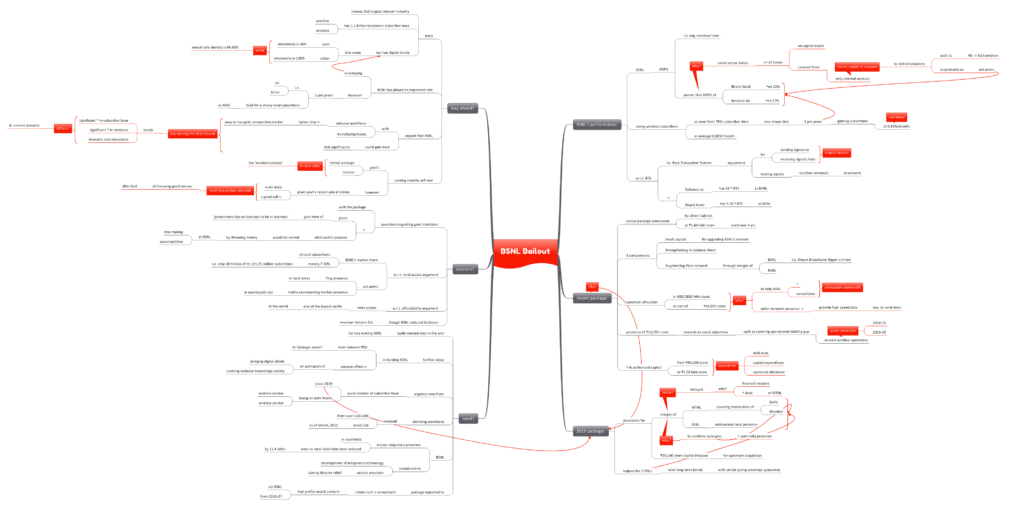BSNL Bailout

From Current Affairs Notes for UPSC » Editorials & In-depths » This topic
IAS EXPRESS Vs UPSC Prelims 2024: 85+ questions reflected
How does BSNL compare to its peers?
- BSNL suffers a poorer ARPU (average revenue per user) than its peers like Bharti Airtel (ARPU increased 23%) and Reliance Jio (ARPU increased 27%).
- This is because BSNL’s social sector duties implies that all losses on capital assets are covered from only the internal accruals. As a result, it is unable to respond to technological innovations (such as transition from 4G to 5G) as promptly as its private sector peers.
- BSNL has been losing wireless subscribers recently. TRAI’s monthly subscriber data shows that it has been losing subscribers at an average 0.30%/ month. At the same time, Airtel and Jio has been acquiring subscribers at an average of 0.43%/ month (combined).
- BTS or Base Transceiver Station is an equipment for sending and receiving radio signals to/ from mobile devices. They route these signals to other terminals in the network. Reliance Jio holds 6 times as many BTS as BSNL whereas Bharti Airtel holds 5.5 times as many BTS.

What does the recent package propose?
- The Union Cabinet recently proposed a revival package of 1.64 lakh crore INR for rescuing BSNL.
- It is to be utilized over the next 4 years.
- The package has 3 main components:
- Fresh capital for upgrading BSNL’s services
- Strengthening its balance sheet
- Augmenting fibre network through a merger of BBNL (Bharat Broadband Nigam Limited) and BSNL.
- There is an allocation of spectrum in 900/1800 MHz band at the cost of ₹44,993 crore.
- This would help BSNL increase and consolidate its serviceable bandwidth.
- With a wider network presence, the public sector telecom provider would be able to provide high speed data– especially to rural India.
- Additionally, the government would provision for ₹13,789 crore for BSNL towards its social objectives. This will help address operational viability gap in rural wireline operations undertaken between 2014-15 and 2019-20.
- The government is to increase the authorized capital from ₹40,000 crore to ₹1.50 lakh crore towards its AGR dues, capital expenditure and spectrum allotment.
What about the 2019 package?
- This isn’t the 1st rescue package for BSNL. A package was designed in 2019 too.
- Among its many features, the 2019 package proposed the merger of MTNL (Mahanagar Telephone Nigam Ltd) and BSNL. This is to combine the synergies of BSNL (with its wide rural presence) and MTNL (covering metro cities of Delhi and Mumbai) to create a pan-India presence.
- This merger has been delayed due to financial reasons, notable, MTNL’s high debt.
- The government had also announced ₹20,140 crore capital infusion for spectrum acquisition.
- The package helped the 2 PSUs raise long-term bonds with the central government providing sovereign guarantee.
Why is this needed?
- The recently announced package is being viewed as a badly needed shot in the arm for loss-making BSNL.
- Any further delay in funding the main telecom PSU in ‘strategic sector’ would adversely affect the government’s goal of bridging the digital divide and creating an inclusive knowledge society.
- The urgency of the need for capital support is seen from the quick erosion of its subscriber base since 2019. It has been losing on both fronts- wireline and wireless connections.
- The PSU has also witnessing a shrinking workforce. The employee base has reduced from over 1.65 lakh to 64,536 as of March, 2021.
- However, the telecom provider continues to enjoy ubiquitous presence in rural India even as its rural wireless subscriber base reduced by 11.4 lakhs.
- It also has a crucial role in development of indigenous technology and service provision during disaster relief.
- The package is expected to create such a turnaround that BSNL would start bringing in profits by 2026-27.
What are the concerns?
- Critics have questioned the government’s intention with this package when it has been repeatedly espousing the view: ‘government has no business to be in business’.
- They have questioned what public purpose would be served by continuing to throw money at an uncompetitive loss-making BSNL.
- The rural access argument is being challenged by the fact that BSNL’s market share of its rural subscribers is merely 7.39% i.e. only 38 million of its 121.25 million subscribers are in rural India. Meanwhile, its private sector peers have increased their presence in rural India and now hold a commanding market presence in the countryside too.
- With regards to the argument that BSNL is necessary to ensure affordability, it is to be noted that India enjoys one of the lowest tariff rates in the world.
- Though BSNL’s losses have reduced, its revenues remain flat.
What is the way ahead?
- India houses the 2nd largest telecom industry in the world. Its telephone subscriber base (wireless and wirelines), as of March 2022, stood at 1.1 billion.
- However, there is a divide between the rural and urban areas. The urban teledensity is 135% and the rural teledensity is 58%, while the overall tele-density is 84.88%.
- BSNL has played an important role in narrowing this gap over the years. However, Jio and Airtel currently hold nearly 5 times as many rural subscribers as BSNL.
- It is argued that BSNL, with its reduced workforce creating a lighter ship, well placed to navigate the competitive marketplace and its reducing losses, could gain back its lost significance.
- However, turning around this ship requires a significant increase in subscribers, revenues and dramatic cost reductions. In the current market scenario, this would be difficult to achieve.
- The coming months will put the government’s package and resolve to save the ‘market balancer’ to the test. Nevertheless, considering how the government’s recent sale of stakes in the loss-making Air India turned out for the good, there is a need to question the rationale behind throwing good money after bad.
Practice Question for Mains:
Explain the recent revival package for BSNL. Critically analyse the need to save such a loss-making PSU. (250 words)
Referred Sources
If you like this post, please share your feedback in the comments section below so that we will upload more posts like this.

